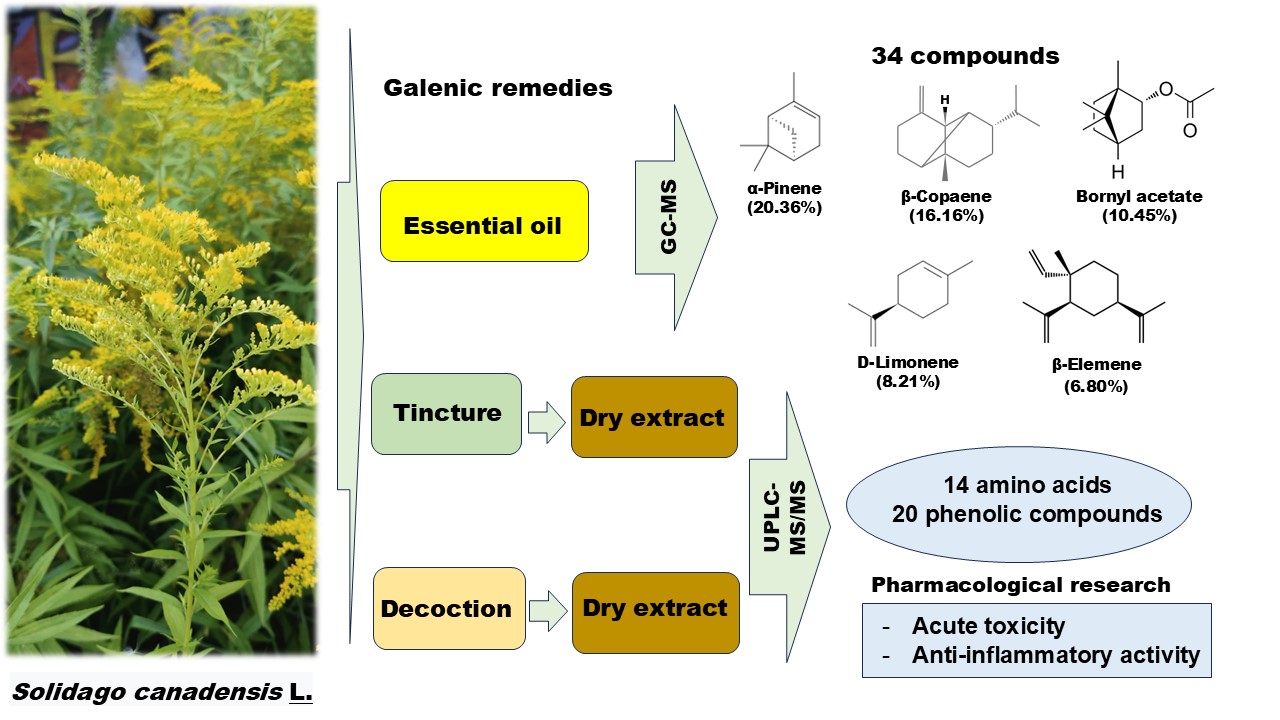 Open Access
Open Access
ARTICLE
Phytochemical and Pharmacological Research in Galenic Remedies of Solidago canadensis L. Herb
1 Department of Pharmaceutical Management, Drug Technology and Pharmacognosy, Ivano-Frankivsk National Medical University, Ivano-Frankivsk, 61002, Ukraine
2 Institute of Pharmacy, Faculty of Medicine, University of Tartu, Tartu, 50411, Estonia
3 Department of Pharmacognosy and Nutriciology, National University of Pharmacy, Kharkiv, 61002, Ukraine
4 Institute of Chemistry, Faculty of Science and Technology, University of Tartu, Tartu, 50411, Estonia
5 Institute of Pharmaceutical Technologies, Lithuanian University of Health Sciences, Kaunas, 44307, Lithuania
* Corresponding Author: Ain Raal. Email:
Phyton-International Journal of Experimental Botany 2024, 93(9), 2303-2315. https://doi.org/10.32604/phyton.2024.055117
Received 17 June 2024; Accepted 23 August 2024; Issue published 30 September 2024
Abstract
Canadian goldenrod (Solidago canadensis L.) is a rhizomatous plant of the Asteraceae family. In folk medicine, Solidago galenic remedies are used for diseases of the kidneys, urinary tract, liver, etc. Externally, goldenrod is used to treat purulent wounds, furunculosis, and gum abscesses as washes and compresses. The aims of this research were to study the yield and chemical composition of essential oil (EO), the anti-inflammatory activity of S. canadensis dry extracts based on its decoction and tincture. In EO (2.8 mL/kg) of S. canadensis were identified and quantified 34 compounds. The principal compounds of the EO from flowering tops of S. canadensis were α-pinene (20.36%), β-copaene (16.16%), bornyl acetate (10.45%), D-limonene (8.21%), and β-elemene (6.80%). In the S. canadensis dry extracts were identified and quantified 20 phenolics (10 flavonoids, 8 hydroxycinnamic acids and 2 phenolic acids) and 14 amino acids, 7 of which are essential. The dominant hydroxycinnamic acids were neochlorogenic and chlorogenic acids, and 4,5-dicaffeoylquinic, 3,5-dicafeylquinic and 3,4-dicafeylquinic acids. The main flavonoids were rutin and isoquercitrin. The main amino acids (more than 1 mg/g) were proline, histidine, serine, alanine, aspartic acid, lysine and glutamic acid. The extracts of S. canadensis were characterized as practically non-toxic substances (toxicity class V). The extracts act on the exudative phase of inflammation. The antiexudative effect of the dry aqueous-alcohol S. canadensis extract was 23.59%, and for the aqueous one –19.26%. The dry aqueous-alcohol S. canadensis extract showed promising anti-inflammatory activity.Graphic Abstract

Keywords
Cite This Article
 Copyright © 2024 The Author(s). Published by Tech Science Press.
Copyright © 2024 The Author(s). Published by Tech Science Press.This work is licensed under a Creative Commons Attribution 4.0 International License , which permits unrestricted use, distribution, and reproduction in any medium, provided the original work is properly cited.


 Submit a Paper
Submit a Paper Propose a Special lssue
Propose a Special lssue View Full Text
View Full Text Download PDF
Download PDF Downloads
Downloads
 Citation Tools
Citation Tools